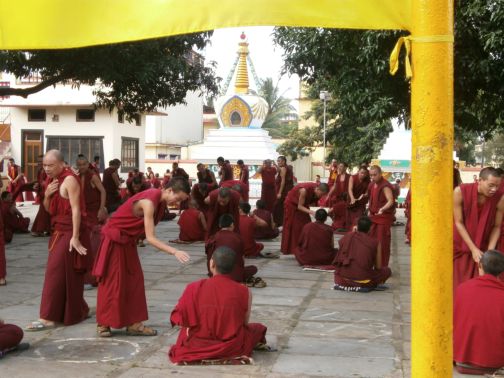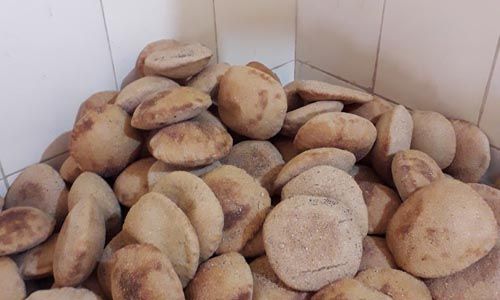The Karnataka government gave 4,000 acres of forested land in Mundgod, near Hubli, in 1966, 7years after the Dalai Lama fled Tibet. Called Doeguling Tibetan Settlement, it's the largest with 18,000 persons. There's much you and I can learn from this serenity, acceptance that there's no country for them for now and a hope that someday things will change.
October 28 – November 3, 2013
Pushpa Iyengar
It’s like you have come to another country. In a way, you have because you are in what is called “mini-Tibet”. Only it’s about 200 km plus from Goa, 40 km driving down country roads from Yellapur and in a village called Tattihalli in Mundgod Panchayat.
Wherever you go, you see monks in twos, threes, even groups in maroon robes serenely going about their business – whether it’s to school/college where they do their Buddhist studies, or whether they are off to pray, or even whether they are ducking into the town’s small eateries which specialize in soups and momos. “The learning goes on from nine to 90,” says Norbu Tsering, who came to this settlement five and a half years ago to teach English and lives with his wards in the unique “family concept” (like a Gurukul) where everyone looks out for everyone else.
It's amazing for mundane humans like us to understand this kind of sharing and caring, no questions asked and no payment in cash or kind expected. There's much you and I can learn from this serenity, acceptance that there's no country for them for now and a hope that someday things will change. As Norbu says, "One day I hope to go back and live in my country." He's 40 now and was born here, lived most of his life in Dharamsala (the seat of the Dalai Lama) but has kept the hope alive that sometime in the future, there's a place for him in his country. And he, like all Tibetans in India, lives in peace and tranquility going about his business.
Beckoned by the Karnataka government
The Karnataka government gave 4,000 acres of mostly forested land in Mundgod, 45 km from Hubli, back in 1966, about seven years after the Dalai Lama was forced to flee Tibet after China invaded it. He set up the Central Tibetan Administration, which fanned out and established different settlements in India, the one close to Mundgod, called Doeguling Tibetan Settlement, being the largest where about 18,000 persons (4,302 when it was first set up) live including nearly 10,000 monks.
Although this settlement does not have the headquarters of the Dalai Lama, he visits often, the latest being in July when he came for the convocation of the monks.
From India to Tibet

From a village which had fallen off the map because it's like any other in India where the nearest town, Mundgod is 5 km away, with its chaotic traffic, its population density most of whom are competing with vehicles on the road, its shops selling everything from plastic ware to steel utensils, its small eateries even including one rooftop bar with a view of the road below that empties out at 8 pm, it has now become a centre of learning of Buddhism.
If a Tibetan family wants to send its son to become a monk, this is where it sends him because of the excellence of the monastic education. The Doeguling Monastic University, a replica of Tibet's reputed 500-year-old Doeguling Monastic University, which was destroyed by the Chinese in 1959, has thousands of student monks from many countries, but largely Tibet, undergoing a rigorous Mahayana-Buddhist theological education.
Two of the 11 villages in this settlement are exclusively devoted to the monastery. There are seven monasteries - Ganden Jangtse, Ganden Shartse, Nyingma, Drepung Loseling, Drepung Gomang, Ratoe and Kagyu Monastery. There's also a nunnery and unlike the monks who are a visible presence, the women in this convent are not seen or heard.
The settlement has nine camps (basically residential colonies for those who are not monks) scattered over the 16 square kilometer area which has nine nursery schools, eight pre-primary schools, one primary school and two secondary schools. For health care there is an allopathic hospital, a Tibetan Medical and Astrological Institute and a few small health clinics in various villages. There's a 32-room guest house that was inaugurated last year donated by Dilys Jetavana, a follower who lives in Singapore, and from the balcony of one of these rooms we hear children in the school across the road singing Tibetan words to the tune of "Twinkle, twinkle, little star". Each of the 11 villages has a head all of whom come under the big chief, the refugee settlement officer.
The life of a monk
The regimen is set :by 6.30 am it's breakfast consisting of Tibetan tea (a milky, salty, buttery tea), and Tibetan bread (chapathi meets bread) and off to study breaking for lunch at 11 am. Hordes of monks leave their classrooms and walk around the town, enjoying the simplicity of their existence apparently not restless to explore the world outside. At 2 pm they are back to their studies till they break for dinner at 5 pm. And then it's prayer, going to the several libraries and homework.
Monday is their Sunday, the day we arrive in the settlement. The few shops that are open are buzzing, the eateries are full, the jeeps that carry them to the main gate are chock-a-bloc with monks with some of the teenagers (boys will be boys!) riding even on the roof.
Life in the settlement
Most of the original families have a small piece of agricultural land on which they mostly grow paddy fed by rainwater in the monsoon. We see a shop selling organic rice and dal. There are also a couple of plots on which organic farming is done, but largely the Tibetans have made the leap to modernity and depend on small businesses.
The market square of this settlement has all the shops and eateries including fruit vendors and autorickshaw stand. The shops that sell a range of goods like shawls, prayer beads, even costume jewellery and incense sticks and eateries that serve up Tibetan fare like momos, soups and noodles are run by Tibetans, the vendors and drivers are locals and an example of two cultures living peaceably with each other. We stop at an eatery where a women is busy scurrying around clearing tables, cooking and taking orders. There's a delicious shap-tak (can be compared to a Goan beef chilly fry only the beef is very tender), a plate of steamed vegetarian momos and ting-mo (steamed bread).
Beginning October, till the end of winter, the men folk go to different parts of India to do their annual wool business, which brings in the money. It's a frugal life that revolves largely around the settlement, with no city lights or luxuries. It's a life spent waiting, waiting in hope that Tibet will be theirs someday.
Note: (While visiting Tibetan settlements in India, whether at Dharamshala/ Bylakuppe/ Dehra Dun/ Mundgod/ Shimla /Manali you should stay at their collection of homestays where you stay with the families, share their food and learn about their culture. For more details, log onto http://www.tibethomestay.com/.
And if you are in Mundgod, insist on Norbu Tsering as your guide because he can take you around the temples/ camps/ monasteries and he's great company.)



